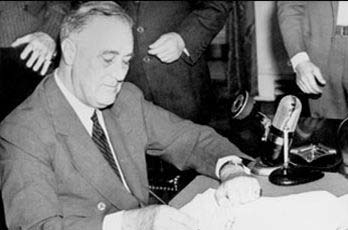 The Selective Training and Service Act of 1940 was enacted on September 16th of that year. It is sometimes referred to as the Burke-Wadsworth act. This was the first such act of conscription in the United States during a time of peace. Conscription is the process that drafts individuals into military service, as opposed to having individuals volunteering.
The Selective Training and Service Act of 1940 was enacted on September 16th of that year. It is sometimes referred to as the Burke-Wadsworth act. This was the first such act of conscription in the United States during a time of peace. Conscription is the process that drafts individuals into military service, as opposed to having individuals volunteering.
This was not however the first time conscription was used in America. In 1861, during the Civil War, men from both Union and Confederate forces were required to join their respective armies. Once again, in 1917, President Woodrow Wilson employed conscription as a means to bolster the armed forces during World War I.
During the late 1930’s members of the U.S. government became concerned over the aggression being displayed by Italy, Japan and especially Germany. With this, President Franklin D. Roosevelt did not hesitate to sign the Burke-Wadsworth act into law to be prepared in advance with the increasing likelihood that the United States would have to defend itself against outsiders.
The Act
This new law required all male United States citizens between the ages of 21 and 35 to register for the draft. Individual names were drawn through a lottery system. If you were called to duty the time of your service would be one year. A provision of the act called for these drafted soldiers to reside only in U.S. territories or possessions, or within the Western Hemisphere. Another provision limited the number of men being trained to 900,000. It also addressed the subject of conscientious objectors. These were men who claimed they could not fight due to their religious beliefs and convictions. If approved by the draft board, these individuals would still be required to enter the military, but would be assigned non-combat duties.
The Draft
The first draft under the new act was held in October of 1940. Midway through 1941, President Roosevelt already felt the need for an extended tour of duty for these draftees. He submitted a bill to accomplish this, which was narrowly approved by the House of Representatives by a one vote margin. It then was passed by the Senate as well. This quick and unexpected addition to their time of service did not fare well with many of the new inductees. Some threatened desertion at the end of the 12 months they had originally signed up for. This action became known as the OHIO protest. The word was at times scrawled on barrack walls. OHIO was an acronym for “Over the Hill In October”. As it turned out, the demonstrations were relatively short lived. After the Japanese attacked Pearl Harbor on December 7, 1941, attitudes changed and thousands of men and women alike volunteered to defend America. Many more thousands were drafted as the United States entered World War II.
Conclusion
With the onset of the second World War, changes were made to the Selective Training and Service Act calling for the registration of all men between the ages of 18 and 65. Further, anyone from 18 years of age through 45 would now be liable for immediate induction into the armed forces. The period of time that a person must serve was also extended to 6 months after the war’s end.
In the 7 year timeframe from 1940 to 1947, over 10,000,000 men were inducted under the act.